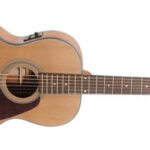The Em9 Guitar Chord is a gateway to a more sophisticated and emotionally resonant sound in your playing. Stepping beyond basic minor chords, the Em9, or E minor ninth, introduces a beautiful complexity that’s widely used across genres from jazz and blues to pop and folk. This guide will break down everything you need to know to master this chord, enriching your musical vocabulary and inspiring new creative pathways on the guitar.
What Makes the Em9 Chord Special?
The Em9 chord isn’t just another minor chord; it’s a richer, more nuanced version. It’s built upon the foundation of the E minor chord, but with added notes that create its signature sound. Specifically, the Em9 chord comprises five distinct notes:
- E (Root – 1)
- G (Minor Third – b3)
- B (Perfect Fifth – 5)
- D (Minor Seventh – b7)
- F# (Major Ninth – 9)
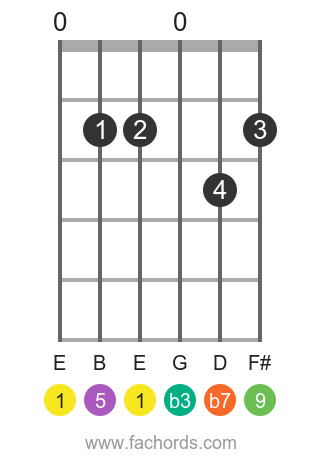 E m9 chord diagram position 1 open voicing – Explore the Em9 guitar chord with this detailed chart for the first open position.
E m9 chord diagram position 1 open voicing – Explore the Em9 guitar chord with this detailed chart for the first open position.
These notes, stacked together, create a lush, almost ethereal quality. The inclusion of the major ninth (F#) adds a melodic sweetness that distinguishes it from a standard Em7 chord, providing a more open and airy feel. Understanding the chord formula helps to see the construction clearly: 1-b3-5-b7-9.
For those looking to deepen their understanding of chord construction, exploring fretboard intervals and how chords are built by stacking intervals can be incredibly beneficial. This theoretical knowledge will empower you to not only play the Em9 but also understand how it relates to other chords and scales.
Exploring Different Em9 Chord Positions
One of the great things about guitar is the variety of ways to play the same chord. The Em9 is no exception, offering multiple voicings across the fretboard. Here are several common positions, ranging from open to movable shapes, to help you find what works best for your playing style and musical context.
Position 1: Open Em9
This is often the first Em9 voicing guitarists learn, utilizing open strings to create a full and resonant sound.
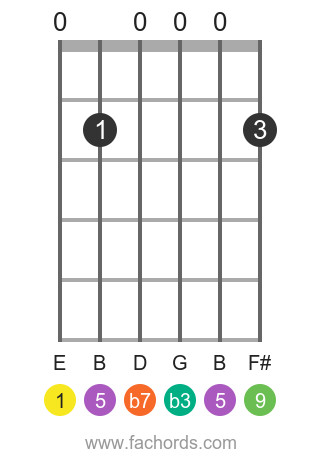 Em9 chord diagram open position 4 – Diagram showing an alternative open position for the Em9 guitar chord.
Em9 chord diagram open position 4 – Diagram showing an alternative open position for the Em9 guitar chord.
Position 2: Movable Em9 Shape
This barre chord shape allows you to play an m9 chord starting from any root note on the E string. Mastering movable shapes is essential for expanding your fretboard fluency.
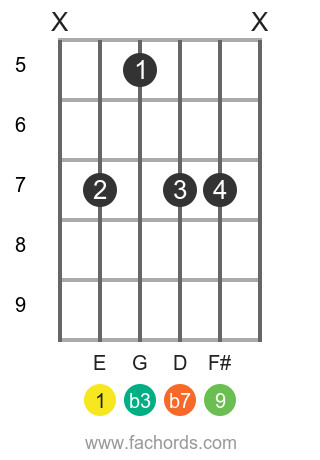 Movable Em9 chord shape position 5 – Learn the movable Em9 barre chord shape for flexible chord transitions.
Movable Em9 chord shape position 5 – Learn the movable Em9 barre chord shape for flexible chord transitions.
Position 3: Another Open Em9 Voicing
This open position offers a slightly different flavor, with a variation in the bass notes and overall texture.
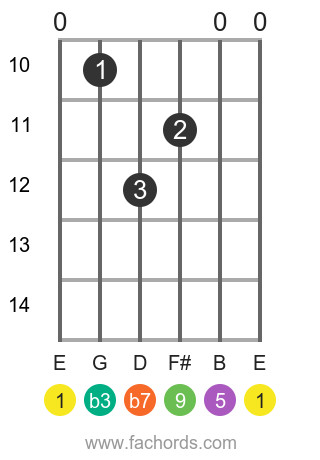 Em9 chord position 3 open voicing – Discover another open Em9 chord voicing for a different tonal color.
Em9 chord position 3 open voicing – Discover another open Em9 chord voicing for a different tonal color.
Position 4: Higher Open Em9 on the Neck
Moving up the neck, this open position provides a brighter and more articulate Em9 sound.
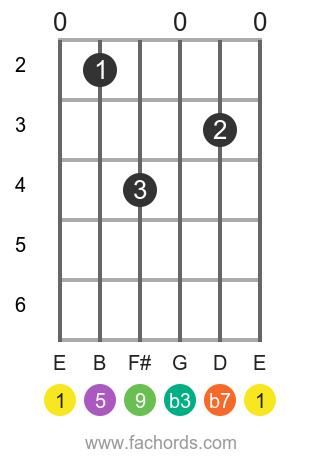 Em9 chord diagram position 7 open higher voicing – Explore a higher register open voicing for the Em9 chord.
Em9 chord diagram position 7 open higher voicing – Explore a higher register open voicing for the Em9 chord.
Position 5: Classic Open Em9 Shape Revisited
Another look at a very common and versatile open Em9 shape.
 E m9 chord diagram position 1 open voicing – Explore the Em9 guitar chord with this detailed chart for the first open position.
E m9 chord diagram position 1 open voicing – Explore the Em9 guitar chord with this detailed chart for the first open position.
Position 6: Alternative Open Em9 Configuration
Experiment with this open shape for a unique sonic texture within your chord progressions.
 Alternative Em9 chord open position 2 – Diagram of an alternative open string configuration for the Em9 guitar chord.
Alternative Em9 chord open position 2 – Diagram of an alternative open string configuration for the Em9 guitar chord.
Position 7: Yet Another Open Em9 Variation
Broaden your Em9 palette with this additional open voicing, offering subtle differences in tone and feel.
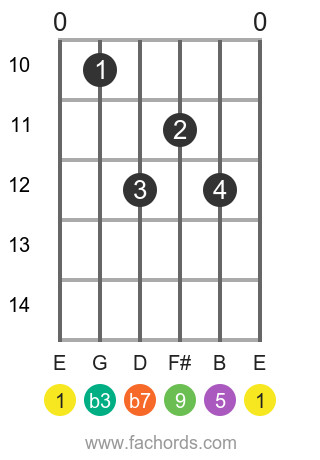 Em9 chord diagram open position 3 variation – A variation on the open Em9 chord, providing a subtly different sound.
Em9 chord diagram open position 3 variation – A variation on the open Em9 chord, providing a subtly different sound.
Exploring these various positions will not only give you different sonic options but also improve your finger dexterity and fretboard knowledge. Remember to practice transitioning between these shapes and incorporating them into your playing.
Where to Use the Em9 Chord
The Em9 is a versatile chord that fits beautifully in many musical contexts. Its melancholic yet hopeful character makes it a favorite in genres like:
- Jazz: Em9 is a staple in jazz progressions, often used as a ii-V-i chord substitution or as a standalone chord for its rich harmony.
- Blues: In blues, the Em9 can add a touch of sophistication to minor blues progressions, offering a more complex alternative to a standard Em chord.
- Pop and Singer-Songwriter: The Em9’s emotional depth makes it perfect for introspective pop and singer-songwriter music, adding a touch of vulnerability and beauty.
- Folk: Its gentle and melodic nature complements folk music beautifully, providing a harmonic richness without being overly assertive.
Experiment with using the Em9 in place of a standard Em or Em7 chord in your songs and progressions. You’ll be surprised at how much it can elevate the emotional impact and harmonic interest of your music.
Conclusion: Embrace the Em9 Sound
The Em9 guitar chord is more than just a technical exercise; it’s a tool for adding depth, emotion, and sophistication to your guitar playing. By learning its construction, exploring different voicings, and understanding its musical applications, you’ll unlock a new dimension in your playing. So, take the time to master the Em9, and let its beautiful sound inspire your musical journey. Explore further into the realm of ninth chords and discover even more ways to expand your harmonic palette on the guitar.

